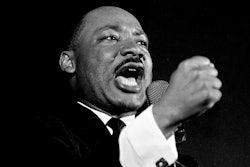Amid the stacks of books, exams to grade, lecture notes and meeting agendas in the office of Dr. Shawn Utsey, chairman of Virginia Commonwealth University’s Department of African American Studies, is a box of bones that are more than 100 years old. The bones, he believes, are part of a dark history few know.
After completing his award-winning documentary “Meet Me In The Bottom,” chronicling the effort to identify and memorialize a slave burial ground in Richmond, Va., Utsey began investigating claims that the slave burial site had been looted for corpses for medical training purposes.
Though Utsey found no evidence of theft from the slave burial site, his research led him to Chris Baker, the man Utsey believes was involved in the theft of possibly hundreds of corpses from Black cemeteries in Richmond. An African-American man born in 1860, Baker was an employee of the Medical College of Virginia (MCV), which merged with another school to form VCU.
Baker is the subject of Utsey’s next documentary, tentatively titled “Chris.”
The documentary calls attention to the dark history of early medical colleges in America. To properly train their students, the schools needed cadavers to slice up. Most states in the 19th century were without so-called anatomy laws, which allowed medical institutions to use executed prisoners and unclaimed bodies for dissection. To make up the difference, some colleges turned to robbing graves.
“It’s very widespread,” says Dr. Michael Sappol, senior historian in the History of Medicine Division of the National Library of Medicine and author of the book, A Traffic of Dead Bodies: Anatomy and Embodied Social Identity in Nineteenth-Century America. According to Sappol, nearly every medical college of the time relied on body snatching.
“If you go through the history of any medical school in the year 1882, there will be some newspaper scandal — rumors or a court case or riot or something — relating to the acquisition of cadavers,” Sappol says. In the middle of the night, men known as “resurrectionists” dug up the recently buried and carried them to medical colleges or middlemen for their payment.
Baker began working for MCV in the 1880s. His tasks included acquiring bodies either personally or by hiring others, keeping abreast of deaths in the Black community and preserving the bodies for dissection. Baker’s listed occupation in the 1890 census is “Anatomical Man.”
In Richmond, the cadaver business was booming.
“Even before the Civil War, MCV and the University of Virginia competed for bodies from Virginia’s big cities,” says Dr. Todd Savitt, a professor at East Carolina University who specializes in African-American medical history. Though there is no sure way to know, estimates of bodies stolen from Richmond’s Black cemeteries number in the thousands.
“The majority of cadavers were African-American — not because they were being targeted, but they were more vulnerable to grave-robbing,” Utsey says. “Municipal cemeteries — they were open, they were unguarded — whereas White folk of the time were buried in churches [or] on their own property, and it was very difficult to steal them.”
Even in states that had anatomy laws there were seldom enough corpses to satisfy the demands of a rapidly growing number of medical colleges.
The dearth of corpses led to the New York Doctors’ Mob in 1788. Grave robbers who had previously stolen bodies mainly from Black cemeteries began stealing from White cemeteries. The public was so outraged that a mob of 5,000 stormed New York Hospital, causing doctors to flee the city for their safety and forcing the governor to dispatch a militia.
In 1882, hundreds of Blacks rallied at the Philadelphia city morgue to protest the robbery of six Black corpses from Lebanon Cemetery. The grave robbers had been caught trying to transport the bodies on the back of a wagon for Jefferson Medical College. The incident eventually led to the passage of a new anatomy act in Pennsylvania.
Baker had a run-in with Virginia law enforcement in 1882. He and three other men were caught disturbing at least eight graves, and Baker was indicted on one felony and two misdemeanor counts of body snatching. Baker was pardoned by the governor.
In 1994, construction workers found a well at MCV with bones the Smithsonian would later determine belonged to 26 separate individuals, some of which had surgical incisions on them. Utsey believes most of those bones, some of which are sitting in his office, came from cadavers acquired by Baker. There is, however, no way to know for certain.
With the help of some of his students, Utsey has completed filming his documentary. While some might be willing to condemn Baker, Utsey contends that there’s more to the story than meets the eye.
“It’s easy to look at him now and judge him, because he was really the inside man to the Black community [who] provided the medical college access to the bodies,” Utsey says. “It’s easy to see him as a pariah … but I think it’s more complex than that.”


















